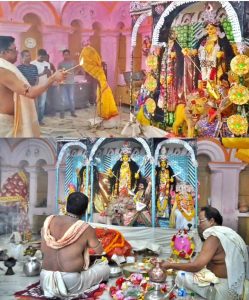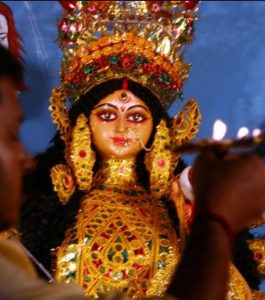Introduction: A Sacred Legacy in the Heart of Tripura
In the bustling capital of Agartala, nestled amidst the rich cultural fabric of Tripura, lies the centuries-old Durga Bari temple, a place where Durga Puja is celebrated with unmatched reverence and unique customs. Unlike conventional temples, Durga Bari hosts two Durga Pujas every year—each rooted in royal legacy and spiritual mysticism.
This temple, established by the Manikya dynasty over 500 years ago, is not just a place of worship but a historical treasure. The celebrations held here are supported by both the state and its royal descendants, showcasing a harmonious blend of tradition, spirituality, and governance.
A Temple Steeped in History and Royal Patronage
The Durga Bari temple was established under the rule of the Manikya kings, who played a crucial role in shaping the religious and cultural identity of Tripura. Located in central Agartala, the temple was built to serve as a royal shrine and continues to carry the spiritual legacy of the erstwhile princely state.
One of the most remarkable aspects of this temple is its continued royal patronage. Even after Tripura’s integration into the Indian Union, the Government of Tripura has upheld its commitment to this sacred tradition. The temple is explicitly mentioned in the instrument of accession signed by the Tripura royal family, cementing its place in the political as well as cultural history of the region.

The Twin Celebrations: Sharadiya and Basanti Durga Puja
Durga Bari temple hosts not just one but two Durga Puja celebrations every year, making it an exceptional spiritual center. The first celebration is Basanti Puja, observed during the Bengali month of Chaitra, marking the end of the Bengali calendar year. The second and more widely celebrated Sharadiya Durga Puja occurs in the autumn months of September or October, during the Bengali month of Ashwin.
Basanti Puja is considered the original form of Durga Puja. It is believed that this celebration dates back to the Vedic era when Goddess Durga was first invoked for victory over evil forces. On the other hand, Sharadiya Puja gained popularity during the era of Lord Ram, who worshipped Goddess Durga before his legendary battle with Ravan. The coexistence of both rituals at Durga Bari showcases a beautiful amalgamation of ancient and epic traditions.
A Divine Revelation: The Origin of the Two-Armed Durga Idol
What makes the Durga Bari temple stand out from other temples across India is the two-armed idol of Goddess Durga. Typically, Durga is depicted with ten arms, each carrying a different weapon symbolizing divine powers. However, at this Tripura temple, the deity is worshipped in a two-armed form.
This unique tradition began with Maharani Sulakshana Devi, the queen of Maharaja Krishna Kishore Manikya. Historical records and oral legends state that the Maharani was overwhelmed and fainted upon witnessing the ten-armed idol during a puja. That very night, she reportedly received a divine vision instructing her to worship the Goddess in a gentler two-armed form.
In reverence to the divine message, the royal family decided to change the idol’s form. Since then, Goddess Durga has been venerated at Durga Bari in this unique representation. According to the temple’s head priest, Jayanta Bhattacharjee, the Goddess still possesses her ten arms, but eight of them remain invisible or latent, representing hidden spiritual strength and grace.
Rituals, Devotion, and Grand Celebrations
Durga Puja at Durga Bari follows meticulously traditional rituals led by a lineage of dedicated priests. The celebrations begin with Maha Saptami, when the temple premises light up with spiritual fervor. Devotees from across the state and beyond gather in large numbers, eager to witness and participate in the ceremonies.
From early morning prayers to animal sacrifices—still performed as an offering to the Goddess in accordance with age-old customs—the temple reverberates with sacred chants and rituals. The intensity heightens with Maha Ashtami and Maha Navami, where special pujas and devotional performances are held.
The grand culmination on Maha Dashami marks the symbolic departure of the Goddess, accompanied by the immersion of the idol. Despite the subdued form of the deity, the celebration retains the grandeur and emotional essence of traditional Durga Puja.
Beyond Durga Bari: The Broader Cultural Impact
While the Durga Bari temple remains the epicenter of unique celebrations, community pujas across Tripura also contribute to the vibrant cultural landscape during this period. Localities in Agartala and surrounding regions set up elaborate pandals, artistic idols, and host cultural programs that attract thousands of visitors.
However, the Durga Puja at Durga Bari holds a distinctive spiritual and historical weight that draws not only devotees but also scholars, historians, and cultural enthusiasts. Its fusion of royal traditions, divine intervention, and localized spirituality has made it an essential part of Tripura’s heritage.


The Temple Today: Sustaining a Living Tradition
The legacy of Durga Bari temple continues to thrive with active support from both the royal family and the Tripura government. This dual backing ensures that rituals are conducted with precision, and the sanctity of the temple is preserved.
In modern times, efforts have been made to promote the temple as a heritage site, inviting pilgrims, tourists, and researchers to explore its rich legacy. The annual celebrations now attract not just locals but also a global audience through digital platforms and social media, further amplifying the story of this one-of-a-kind Durga Puja.
Conclusion: A Testament to Faith and Culture
The Durga Puja at Tripura’s Durga Bari temple is more than a religious event—it is a living chronicle of faith, royal legacy, and divine grace. From a queen’s mystical vision to a state-supported ritual, this celebration redefines devotion through its uniqueness.
In a world where cultural homogenization often blurs local traditions, the Durga Bari temple stands tall as a beacon of distinctiveness and spiritual authenticity. As devotees bow before the two-armed Goddess year after year, they pay homage not only to divine power but also to centuries of unbroken tradition.
Read More: Discover how Assam’s traditional jewellery, Axomiya Gohona, recently earned the prestigious Geographical Indication (GI) tag, preserving a centuries-old heritage.

